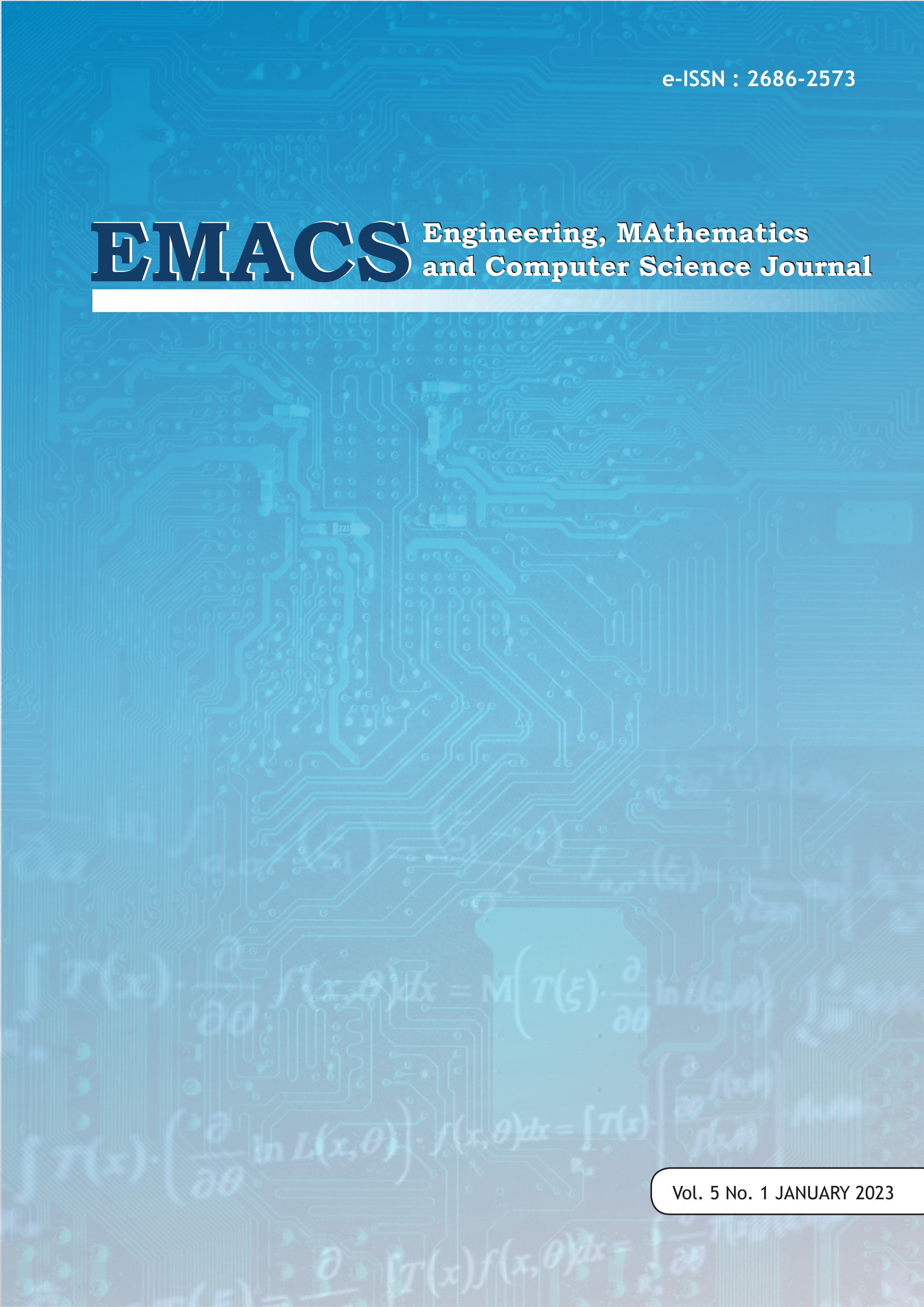Operasi Dasar Baris/Kolom Matriks Secara Interaktif Dengan Menggunakan R
DOI:
https://doi.org/10.21512/emacsjournal.v5i1.9206Keywords:
Systems of Linear Equations, R Programming, Numerical Methods, Elementary Row Operations, Gauss-Jordan MethodAbstract
The linear algebra applications available today usually only provide the result. So, it is a challenge to overcome this, and innovation is needed in the computing aspect. One of the popular and open-source programming languages ​​is R. The computational innovation in R needs to be explored further, to explore the R programming logic. The creation of a function environment with the list function and the involvement of local and global variables/objects has received little attention. Based on the problems formulated, this study proposes two objectives, namely (1) developing an R program that is able to provide interactive and step-by-step solutions, to obtain a solution of a system of linear equations, and (2) to explore R’s ability to create and handle global variables. An R program is created, starting with creating a function environment. This function environment is filled with four related functions, namely “exchangeâ€, “multiplyâ€, “foldâ€, and “yieldâ€. These four functions are connected to each other through a global object. Users can type in each function to perform row/column operations, interactively and step by step. The environmental function in this program, is named OBE. The OBE function accepts input in the form of a coupling matrix derived from a system of linear equations. The final result of this interactive process chain is given by the “result†function. The result function will display two matrices, namely the Original Matrix which is the input and the Equivalent Matrix.
References
Anton, H., & Anton Kaul. (2019). Elementary Linear Algebra, 12th Edition. John Wiley & Sons, Inc. New York, USA.
Berkelaar, M. et al. lpsolve package, (2020). https://cran.r-project.org/web/packages/lpSolve/index.html
Cut Intan Salasiyah. (2017). Pengembang-an Modul Aljabar Linear Untuk Mahasiswa Pendidikan Matemati-ka. Al-Khawarizmi: Jurnal Pendi-dikan dan Pembelajaran Matemati-ka. E-ISSN 2549-3914. Halaman. 146-156. Vol. 1, No. 2, Desember 2017.
Dona Fitriawan. (2020). Pengembangan Bahan Ajar Aljabar Linear Elementer Berdasarkan Kemam-puan Koneksi Matematis. Jurnal Pendidikan Matematika dan IPA. Vol. 11, No. 2 (2020) h. 217-229. https://jurnal.untan.ac.id/index.php/PMP
Fawzi, Alhussein. at al (2022). Discover-ing faster matrix multiplication algorithms with reinforcement learning. Nature. 610, pages 47–53 (2022). https://www.nature.com/articles/s41586-022-05172-4.
Fieller, Nick. (2018). Basics of Matrix Algebra for Statistics with R. CRC Press, Taylor and Francis Group. New York. https://xn--webducation-dbb.com/wp-content/uploads/2018/07/Basics-of-Matrix-Algebra-for-Statistics-with-R.pdf
Friendly, Michael. (2022). Package ‘matlib’: Matrix Functions for Teaching and Learning Linear Algebra and Multivariate Statistics. https://cran.r-project.org/web/packages/matlib/matlib.pdf
Gharib, S., Syeda Roshana Ali, Rabia Khan, Nargis Munir & Memoona Khanam. (2015). System of Linear Equations, Guassian Elimination. Global Journal of Computer Science and Technology: C Software & Data Engineering. Volume 15 Issue 5 Version 1.0. ISSN: 0975-4172
Hidayati, V R., M A Maulyda, G Gunawan, A N Rahmatih, and M Erfan. (2019). System of Linear Equation Problem Solving: Descriptive Study about Students’ Mathematical Connection Ability. The 1st Progress in Science and Technology Research Symposium (PSTRS). Journal of Physics: Conference Series.
Ruswana, A. M. (2019). Analisis Kemam-puan Pemahaman Matematis pada Kuliah Aljabar Linier Elementer. Journal Cendekia: Jurnal Pendidikan Matematika. Volume 03, No. 02, Agustus 2019, pp. 293-299
Venables, W.N., D.M. Smith, and the R Core Teams. (2022). An Introduction to R: Notes on R: A Programming Environment for Data Analysis and Graphics Version 4.2.2 (2022-10-31). The Comprehensive R Archive Network (r-project.org)
Wilda Mahmudah. (2020). Analisis Kesalahan dalam Menyelesaikan Soal Sistem Persamaan Linear pada Aljabar Linier Elementer. Briliant: Jurnal Riset dan Konseptual. Vol. 5, No. 3 (2020) h. 449-456. http://jurnal.unublitar.ac.id/index.php/briliant/article/view/463/pdf
Xingping Sheng. (2014). Execute Elementary Row and Column Operations on thePartitioned Matrix to Compute M-P Inverse ð´. Hindawi Publishing Corporation Abstract and Applied Analysis Vol 2014, Article ID 596049, 6 pages https://www.researchgate.net/publication/275556465_Execute_Elementary_Row_and_Column_Operations_on_the_Partitioned_Matrix_to_Compute_M-P_Inverse
Yoshida, Ruriko. (2021). Linear Algebra and Its Applications with R. Taylor & Francis Group, LLC.
Yudistira, I G.A. Anom. (2021). Pengembang-an Simulasi Kejadian Diskret Berbasis Paket Simmer pada R. Jurnal EMACS (Engineering Mathematics and Computer Science). Vol 3 No. 2 May 2021: 79-85.
Downloads
Published
How to Cite
Issue
Section
License
Copyright (c) 2023 Engineering, MAthematics and Computer Science (EMACS) Journal

This work is licensed under a Creative Commons Attribution-ShareAlike 4.0 International License.
Authors who publish with this journal agree to the following terms:
- Authors retain copyright and grant the journal right of first publication with the work simultaneously licensed under a Creative Commons Attribution License - Share Alike that allows others to share the work with an acknowledgment of the work's authorship and initial publication in this journal.
- Authors are able to enter into separate, additional contractual arrangements for the non-exclusive distribution of the journal's published version of the work (e.g., post it to an institutional repository or publish it in a book), with an acknowledgment of its initial publication in this journal.
- Authors are permitted and encouraged to post their work online (e.g., in institutional repositories or on their website) prior to and during the submission process, as it can lead to productive exchanges, as well as earlier and greater citation of published work.
USER RIGHTS
All articles published Open Access will be immediately and permanently free for everyone to read and download. We are continuously working with our author communities to select the best choice of license options, currently being defined for this journal as follows: Creative Commons Attribution-Share Alike (CC BY-SA)





